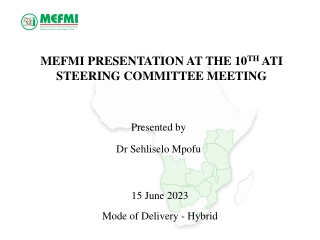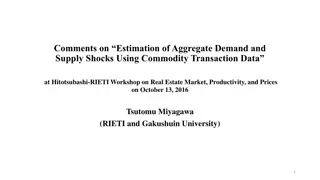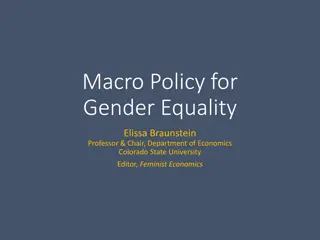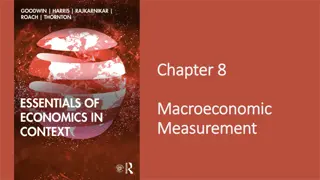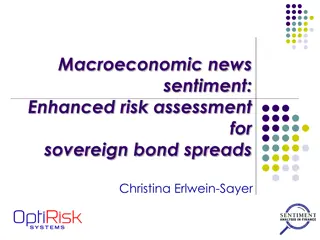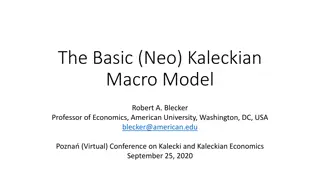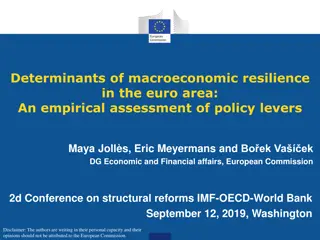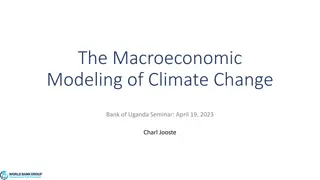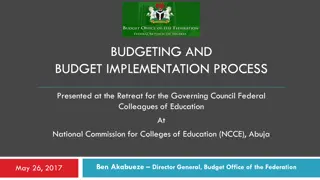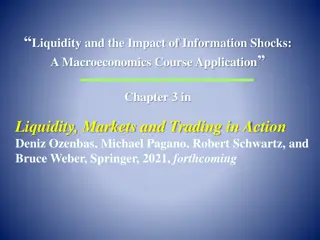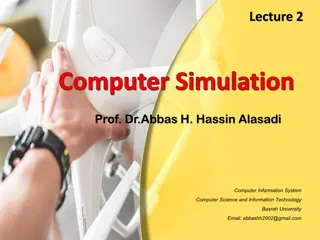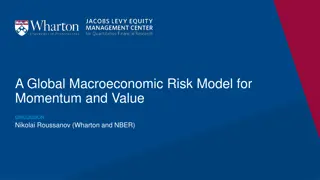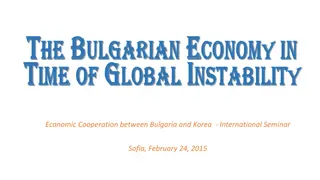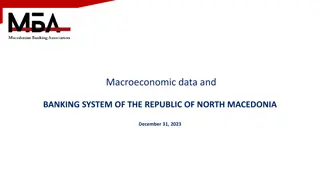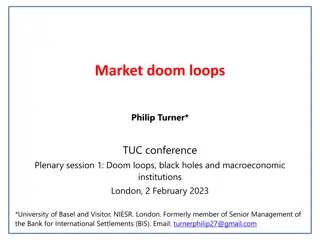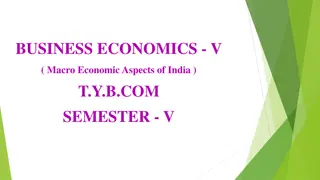MEFMI Presentation on Collaboration and Capacity Development with ATI and IMF
The Macroeconomic and Financial Management Institute of Eastern and Southern Africa (MEFMI) presented on their collaboration with the African Training Institute (ATI) and the International Monetary Fund (IMF) at the 10th ATI Steering Committee meeting. The collaboration includes joint regional cours
7 views • 7 slides
System Models in Software Engineering: A Comprehensive Overview
System models play a crucial role in software engineering, aiding in understanding system functionality and communicating with customers. They include context models, behavioural models, data models, object models, and more, each offering unique perspectives on the system. Different types of system
7 views • 33 slides
Analysis of Contemporary Macroeconomic Issues in Papua New Guinea
Professor Stephen Howes, Director of Development Policy at Australian National University, presents his personal views on macroeconomic issues in Papua New Guinea. The focus is on the exchange rate regime and its management, excess liquidity, and fiscal policy. Various economic indicators point to c
7 views • 48 slides
Models of Teaching for Effective Learning
Models of teaching serve as instructional designs to facilitate students in acquiring knowledge, skills, and values by creating specific learning environments. Bruce Joyce and Marsha Weil classified teaching models into four families: Information Processing Models, Personal Models, Social Interactio
5 views • 28 slides
Complaints Handling Procedures at Macroeconomic and Financial Management Institute
Effective complaints handling is essential for feedback and improvement in financial services. Learn about the benefits, principles, and responsibilities involved in managing complaints at the Macroeconomic and Financial Management Institute of Eastern and Southern Africa.
4 views • 21 slides
Estimation of Aggregate Demand and Supply Shocks Using Commodity Transaction Data
This study presented at Hitotsubashi-RIETI Workshop analyzes demand and supply shocks using commodity transaction data. By estimating elasticity parameters and examining movements in price and quantity, the research identifies negative supply shocks post-global financial crisis and after 2013. The p
0 views • 8 slides
The IS-LM Model for Macroeconomic Analysis
The IS-LM model, discussed in Chapter 12 of Macroeconomics, helps analyze how an economy responds to policy changes and shocks in the short run. By understanding the IS and LM curves and their intersection, we can evaluate short-run macroeconomic outcomes for real interest rates (r) and real output
3 views • 103 slides
Policy Pro-cyclicality in Macroeconomic Theory
Delve into the concept of policy pro-cyclicality in macroeconomic theory through the insights shared by Jeffrey Frankel at a seminar at Harvard Economics Department. Explore examples of pro-cyclicality in developing countries, euro periphery countries, and US political scenarios, along with discussi
1 views • 42 slides
Gender Inequality and Macroeconomic Policy
Exploring the differential impacts of macroeconomic structures and policies on gender equality, this analysis delves into issues such as gender-biased access to resources, labor-intensive export orientation, and the effects of inflation targeting. It highlights how women, especially in marginalized
3 views • 14 slides
Macroeconomic Policy for Development and Decent Work in South Africa
This research agenda delves into the core conclusions, policy context, and objectives of macroeconomic policy for facilitating development and decent work in South Africa. Key points include the need for structural transformation, challenges in job creation, and the link between macroeconomics, empl
4 views • 44 slides
Macroeconomic Measurement: GDP, Unemployment, and Labor Force Analysis
This content explores various aspects of macroeconomic measurement, including GDP calculation, real vs. nominal GDP, GDP deflator vs. CPI, and unemployment rates for different groups. It provides tables and figures to illustrate these concepts and data sources from reputable organizations like the U
20 views • 13 slides
Macroeconomic Policy in the Eurozone: Challenges and Alternatives
The macroeconomic policies in the Eurozone led by the Troika (ECB, European Commission, IMF) have been criticized for contributing to slow growth and high unemployment. This analysis by Mark Weisbrot delves into the negative impact of fiscal, monetary, and exchange rate policies on troubled economie
7 views • 32 slides
Enhancing Risk Assessment for Sovereign Bond Spreads with Macroeconomic News Sentiment
Eurostars project SENRISK aims to develop an automated credit risk assessment tool for fixed income products by incorporating news sentiments. This innovative Decision Support System enhances predictive risk models using sentiments from macroeconomic news and social media. The project focuses on val
4 views • 24 slides
Neo-Kaleckian Macro Model Overview
This presentation explores the Neo-Kaleckian macroeconomic models, examining their development, key elements, and unique features within the broader context of economic theories. It delves into the first-generation models by Harris and Asimakopulos, focusing on markup pricing, labor costs, profit sh
5 views • 22 slides
Assessing Macroeconomic Resilience in the Euro Area
This study assesses the determinants of macroeconomic resilience in the Euro area, emphasizing the importance of economic resilience to absorb shocks, promote convergence, and achieve short-term gains like lower unemployment and higher income. The framework includes components such as absorption, re
2 views • 18 slides
Macroeconomic Modeling of Climate Change in Policy Making
In this seminar by Charl Jooste at the Bank of Uganda, the discussion revolves around the essential ingredients for macro models to incorporate climate policy and climate change. The talk highlights the need to augment standard macroeconomic functions, react to price signals, and link macro models w
1 views • 48 slides
Budgeting and Budget Implementation Process in Government
This presentation delves into the concepts of budgeting and budget implementation in the context of government finance, focusing on fiscal policies, macroeconomic goals, and the budget framework. It explains how budgets reflect government priorities and strategies to achieve economic stability and g
2 views • 26 slides
Impact of Macroeconomic Information on Stock Prices
Relationship between macroeconomic information shocks and stock prices. Discover how unexpected news and investor expectations influence market dynamics, leading to changes in stock valuations. Gain insights into the interplay between economic news, trading motivations, and market behavior.
2 views • 35 slides
Macroeconomic Impacts on the U.S. of Maritime Supply-Chain Shocks Associated with the War in Ukraine
Macroeconomic impacts of the Ukraine War on the U.S. maritime supply chain highlighted with disruptions in global markets for commodities like grains and metals. Analysis includes challenges faced due to the war and the cascading effects on the economy.
2 views • 22 slides
Computer Simulation Models Classification
Computer simulation models are classified based on various characteristics such as static or dynamic, deterministic or stochastic, and discrete or continuous. Static models represent systems at a specific point in time, while dynamic models depict changes over time. Deterministic models involve no r
4 views • 8 slides
International Macroeconomic Statistics for Sound Decision Making
Providing decision makers with the international macroeconomic statistics they need to ensure quality and fit for sound decision making. Challenges, responses, and frameworks discussed at a special session in Athens, Greece by the Committee for the Coordination of Statistical Activities. IMF's effor
0 views • 7 slides
Activity in Context
Macroeconomic landscape through figures depicting global production trends, GDP evolution, and atmospheric carbon dioxide growth. A bathtub-style stock-flow diagram provides insight into interconnected variables. Delve into macroeconomic data spanning decades to gain a comprehensive understanding of
0 views • 6 slides
Global Macroeconomic Risk Model for Momentum and Value
In this discussion, Nikolai Roussanov presents a research paper exploring the profitability of value and momentum strategies across global equities and asset classes. The study relates expected returns to sources of fundamental macroeconomic risk, shedding light on the interplay between value and mo
2 views • 19 slides
Demography's Impact on Macroeconomic Recovery in Finland Post-Financial Crisis
This study delves into the role of demography in the macroeconomic development of Finland after a financial crisis. It analyzes Finnish macroeconomic performance in comparison to European countries, focusing on GDP per capita, labor productivity, and employment-population ratio. The research also ex
2 views • 17 slides
Relevance of G-20 Data Gaps Initiative for Financial Stability Analysis
It has been acknowledged that the global financial crisis has reshaped the approach towards macroeconomic policies. The focus now includes analyzing macro-financial risks and ensuring financial stability. Initiatives like the G-20 Data Gaps Initiative and the SDDS Plus play a crucial role in support
5 views • 15 slides
Impact of Macroeconomic Factors on Income Inequality in Asia
This presentation explores the rising income inequality in Asian countries despite significant economic growth, highlighting the key determinants of inequality including macroeconomic, political, and demographic factors. Trends in income distribution and implications for inclusive growth are analyze
4 views • 17 slides
Romania Macroeconomic and Financial Markets Outlook - Major Trends in Economy
Slow economic recovery in Romania post-crisis, with uneven sector performance. Strong exports driving GDP growth but facing macroeconomic imbalances. Analysis by Ionut Dumitru, Chief Economist at Raiffeisen Bank Romania.
5 views • 32 slides
Neural Net Language Models & Statistical Models
Neural net language models & statistical language models, n-grams, Markov models, and practical order models. Dive into neural probabilistic language models and scaling properties of models, including performance perplexity. Discover the evolution and challenges of language modeling.
3 views • 22 slides
Insights into China's 2015 Macroeconomic Shifts and Policy Landscape
Delve into the macroeconomic trends of China in 2015 as outlined by the Chief Economist of Guotai Junan Securities, Lin Caiyi. The analysis covers the transition from investment-led growth to consumption-driven economy, reforms in investment and financing systems, and the evolving industrial structu
3 views • 19 slides
Austrian Business Cycle Theory and Macroeconomic Models
Explore the concept of Austrian Business Cycle Theory and the fundamentals of macroeconomic models through a detailed presentation with figures depicting the magic formula for economic growth, examples of business cycles, and the structure of production. Gain insights into investment, capital accumu
0 views • 60 slides
Macroeconomic Framework and Fiscal Policy in Tunisia
Explore the concept and uses of a macroeconomic framework, functional relationships in financial programming, and the significance of macroeconomic sectors in Tunisia's economic policy development.
2 views • 31 slides
Economic Cooperation Between Bulgaria and Korea - Seminar Highlights and Macroeconomic Indicators
Discover the potential for economic cooperation between Bulgaria and Korea through an international seminar held in Sofia. Learn about Bulgaria's strategic location, macroeconomic indicators, and balance of payments. Explore opportunities for growth and collaboration in this dynamic partnership.
2 views • 14 slides
Macedonian Macroeconomic Data and Banking System Overview
Explore key economic indicators, banking sector statistics, and macroeconomic environment of North Macedonia as of December 31, 2023. Learn about credit rating, GDP growth, inflation, unemployment, and more.
0 views • 10 slides
EU Energy and Climate Policy - Macroeconomic Implications & Policy Considerations
Explore the EU Energy and Climate Policy's macroeconomic impacts and complexities, including interactions with other EU targets and policies. Understand the challenges and potential solutions for achieving the 20-20-20 targets while maintaining competitiveness and sustainability.
1 views • 28 slides
Impact of Global Supply Chain and Macroeconomic Policy on Strikes and Living Standards in Vietnam
Explore the impact of global supply chain and macroeconomic policy on strikes and living standards in Vietnam. Learn about the Vietnam Strike Wave, new observations, methodology, definition of strikes, and the shift from relative labor peace to a strike wave.
4 views • 29 slides
Risk Assessment in Macroeconomic and Financial Management Institute
Explore key issues in risk assessment at the Macroeconomic and Financial Management Institute of Eastern and Southern Africa, covering topics such as consumer compliance risk, inherent risks, and categories of risks. Gain insights into market conduct, internal controls, and impact assessments in the
3 views • 25 slides
Market Doom Loops and Macroeconomic Institutions Overview
Explore the interplay of market doom loops and macroeconomic institutions through case studies such as bond market vigilantes and fiscal austerity. Discover the impact of monetary policy responses on fiscal decisions and the consequences of below-target inflation and excess unemployment. Gain insigh
2 views • 15 slides
Macroeconomic Measurement: Environmental and Social Dimensions Overview
Explore the relationship between GDP per capita and subjective well-being, Genuine Progress Indicator data for the United States, GPI vs. GDP per capita trends, BLI for selected countries, Human Development Index rankings, gender-based paid and unpaid work statistics, and Adjusted Net Saving rates i
1 views • 9 slides
Macro Economic Aspects of India: NEP 1991 Policy Changes
Explore the macroeconomic aspects of India focusing on the New Economic Policy (NEP) of 1991. Learn about the rationale behind the policy changes, including fiscal crisis, balance of payments crisis, and inflationary pressure. Discover important policy changes in NEP 1991, such as macroeconomic stab
0 views • 35 slides
Macroeconomic Model Development for Default Rate Prediction
Dive into the process of developing a predictive macroeconomic model to estimate future default rates, analyzing macroeconomic factors affecting Slovak economy, and incorporating forward-looking elements for provisions calculation and stress testing in banking scenarios.
2 views • 17 slides
